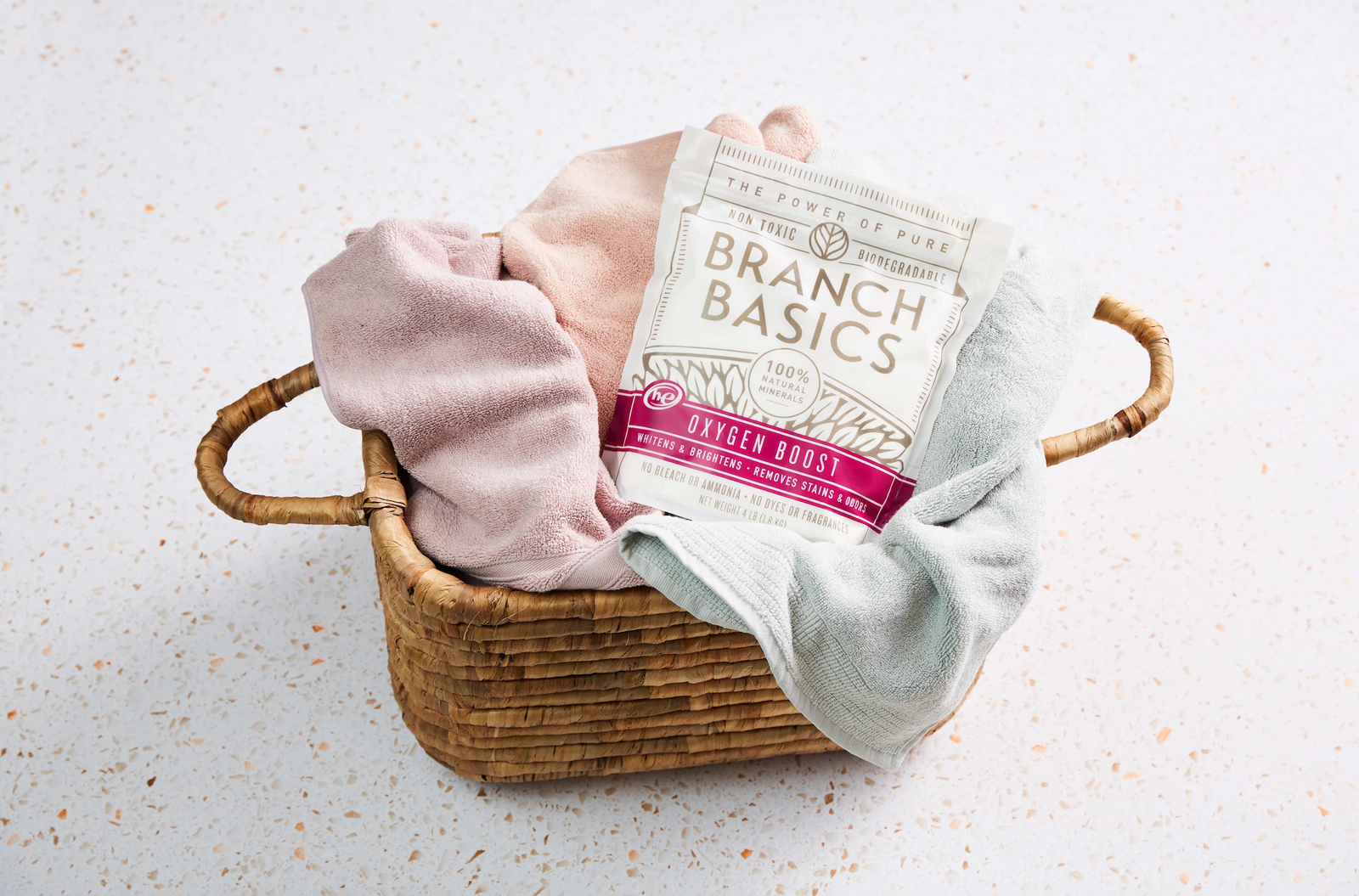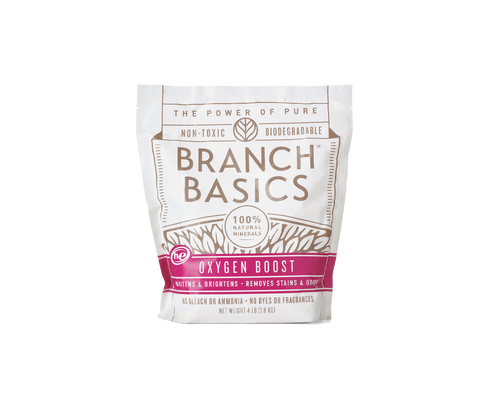How to Clean White Clothes Without Bleach: 7 Natural & Effective Methods

Keeping whites their whitest and brightest typically requires regular bleaching.
However, as discussed in previous articles, chlorine bleach (sodium hypochlorite) is one of the most toxic and dangerous cleaning, laundry, and disinfectant chemicals in most homes.
Fortunately, safe bleach alternatives do exist, and work wonders on white clothing.
In this article, we’ll share seven human-safe ways to clean white clothes without bleach that will whiten and brighten even the dingiest fabrics. Let's dive into our favorite methods!
1. Natural Sunlight
Line-drying clothing is a wonderful way to reduce your energy bill, freshen clothing, and take advantage of the sun’s natural bleaching properties.
We also recommend sunning to help speed the outgassing or off-gassing of new products and new or used clothing.
To “bleach” your white clothes with sunshine, simply lay them out in a sunny part of your yard or porch during the hottest or sunniest part of the day and let the sun do its magic.
To sun your clothing, sheets, comforters, cloth diapers, etc. simply place them in direct sunlight for a few hours and watch those stains fade away.
Here are a few things to keep in mind when bleaching with sun:
- For optimal stain removal and bleaching, put clothes outside when the sun is at its strongest. This is usually at high-noon to about 3 PM.
- Natural sunlight will fade colors, so it is best to use on white or light-colored clothing OR to turn colored clothes inside out.
- The sun’s rays will be strongest in the summer, but they will also work in other seasons (just not as dramatically in most geographical locations).
- Always shake out your clothing, etc. before bringing it inside (nature does harbor some insects that may accidentally attach themselves to your garments).
2. Hydrogen Peroxide
Hydrogen peroxide is the original non-toxic bleach alternative.
Hydrogen peroxide is made from two elements: two hydrogens and two oxygen (H2O2) molecules, and breaks down as such in our bodies and the environment.
Our bodies also make hydrogen peroxide, which is typically broken down by specific enzymes that decrease as we age.
Insofar as environmental safety is concerned, hydrogen peroxide is considered a non-toxic and environmentally-friendly substance because it breaks into hydrogen and water.
Therefore, hydrogen peroxide is considered a safe and non-toxic product for people and the planet.
Try these methods to use Hydrogen Peroxide to whiten and brighten your whites:
- Add 1 cup of 3% hydrogen peroxide (in the brown bottle) to your washer’s bleach dispenser.
- Soak dingy whites in 1 cup of hydrogen peroxide mixed in a basin or bowl of warm water for 1-3 hours.
- Use hydrogen peroxide straight (it’s already diluted, hence the name “3% hydrogen peroxide) to remove stains on white clothes.
Learn more ways to use hydrogen peroxide for non-toxic cleaning and laundry in: How to Clean with Hydrogen Peroxide: A Safer Alternative for Cleaning, Disinfecting & More
3. Branch Basics Oxygen Boost
Branch Basics Oxygen Boost contains just two powerful, human-safe ingredients that act as natural bleach alternatives:
- Baking Soda
- Sodium Percarbonate
Baking soda, also known as sodium bicarbonate, has a natural bleaching and whitening effect on clothing and can help remove dinginess while naturally softening your clothes.
Baking soda is also non-toxic to humans and the environment.
Sodium percarbonate, also known as powdered peroxide or oxygen bleach, is a powerful bleach alternative that releases a mixture of oxygen, water, and washing soda when added to water, making it an excellent bleaching and laundry agent.
To Use Oxygen Boost To Clean Dingy White Clothes:
- Add 1-2 scoops of Oxygen Boost to a large bowl or basin or warm or hot water (warm or hot water is required to activate the stain-lifting oxygen bubbles in sodium percarbonate).
- Add clothing and soak for several hours or overnight.
- Launder as usual using Branch Basics Laundry or your favorite healthy laundry soap.
To use Oxygen Boost To Maintain Clothing’s White Color
- Add 1 scoop of Oxygen Boost to your laundry and launder as usual.
- Remember, colored clothing can dull white clothes, so launder whites and colors separately.
4. Baking Soda
We already mentioned baking soda as an ingredient in the bleach alternative, Oxygen Boost.
However, baking soda can also be used alone to whiten and brighten white clothes.
To use baking soda as a bleach alternative:
- Dissolve 1 cup of baking soda in about 1 gallon of hot water.
- Add white clothes, and soak for several hours or overnight.
- Remove and launder as usual.
You may also choose to add 1 cup of baking soda to your laundry when washing whites to help maintain their brightness and color.
5. Distilled Vinegar
Distilled white vinegar is another secret weapon for non-toxic laundering, bleaching, and cleaning in general.
The acetic acid in distilled white vinegar has a bleach-like effect, and brightens clothing and removes stains without harming fabrics.
For brightening dingy whites (100% cotton):
- Add 1 cup of vinegar to a big sink full/basin-full of hot water.
- Soak socks, sheets, undershirts, etc., overnight and launder as usual.
Distilled white vinegar can also be used to keep dark clothing from becoming dull. It works by removing residues that can fade colors over time. To use, add about half a cup to the final rinse cycle.
You can also use distilled white vinegar instead of bleach to clean and detoxify your washing machine. To learn more, see: 12 Ways to Use Distilled Vinegar in your home.
6. Lemon Juice
Lemon juice, either fresh or bottled, contains natural citric acid, which acts as a natural bleaching agent on stains and dingy white clothing.
It’s also excellent for removing stains, such as armpit stains, without damaging fabrics.
Here’s how to use lemon juice to brighten whites.
For dingy clothing, mix half to 1 cup of lemon juice with about 1 gallon of hot water and soak clothing for several hours, or overnight.
Launder as usual the following day.
For maintaining your whites, add 1 cup lemon juice to your washing machine and launder as usual.
For more non-toxic stain removal tips, check out: How To Get Oil Stains Out Of Clothes Naturally.
7. Branch Basics Laundry Detergent
Our powerful Laundry Detergent effectively lifts stains and removes odors with just one scoop- all without the use of harmful bleach and other ingredients.
Here’s how to effectively use our laundry detergent:
Add 3/4 scoop of powder into detergent drawer. If no detergent drawer, add 3/4 scoop directly into the drum before adding laundry. For large or heavily-soiled loads, add 1 - 2 scoops.
Why is Bleach Harmful?
Bleach is one of the most prevalent chemicals found in American households.
From laundry products to disinfecting wipes, toilet bowl cleaners, and all-purpose sprays, the scent of chlorine bleach has become synonymous with a clean and sanitized home.
However, that doesn’t mean bleach is, or ever was, safe for humans or the environment.
The truth is, the use of and passive exposure to bleach has been linked to various concerning health outcomes, including:
- Severe skin, eye, and lung burns due to the chloramine gas created when bleach is combined with other chemicals or organic matter.
- Increased rate of miscarriage and preterm birth.
- DNA damage, cancer, asthma, respiratory problems, headaches, and a host of other illnesses.
8 Impaired immunity due to microbiome disruption. - Water treated with sodium hypochlorite (and its cousins) has been shown to release chloroform gas when mixed with organic matter, such as urine or dirt. This is problematic when bathing because the chlorine mixes with your organic matter (the stuff you’re washing off), then the steam intensifies that gas exposure. A Taiwanese study showed an increased cancer risk in those who showered in highly chlorinated water.
- Passive exposure can cause an increased risk of respiratory illness and other illnesses in children.
Most of us are aware of the dangers of ingesting bleach or inhaling too much.
However, few people are aware of the aforementioned dangers of passive exposure, which could come from cleaning your home or bleaching your clothes.
Once you become aware of this, it becomes apparent that regulatory agencies aren’t doing enough to educate people on the potential harms of regular or passive bleach exposure.
Bleach is also hazardous to the environment (bleach + organic matter = chloroform gas) and not recommended for septic systems.
Which means, it’s up to us as individuals to stop funding the bleach industry and find safer alternatives, so let’s get started!
Learn more in: Is Sodium Hypochlorite (Bleach) Toxic?
What Causes White Clothing & Fabric to Soil?
Many things can contribute to the soiling or dulling of white clothing, including:
- Detergent build-up
- Synthetic fabric softener build-up
- Color transfer from other clothes (which is why separating colors and whites is recommended)
- Body oils or oils from lotions and cosmetics
- Untreated or poorly treated stains
- Air pollution from environmental factors, cigarettes, smoke, smog, etc.
The good news is you can restore your whites to their original bright and crisp color, without resorting to toxic bleach.
Toss the Toxins With Branch Basics
We hope this article has helped you feel empowered to whiten your clothes naturally without chlorine bleach.
By doing so, you’ll preserve the integrity of your clothing and help protect your environment while creating a much safer and healthier home.
To learn more about how Branch Basics Concentrate plus Oxygen Boost can be used to replace every single cleaning and laundry product in your home, Starter Kits (available in glass or plastic ) or $5.00 trial kit here.
For more tips on natural cleaning, healthy living, and more, check out our blog library, cleaning tips and tricks, podcast, and Toss The Toxins Online Course.
Have Questions? We’ve Got Answers
Swapping out bleach for safe alternatives is a big deal, especially if you’ve relied on bleach for years.
To help, we’re answering some FAQs.
How effective are natural bleach alternatives in keeping clothes white?
Any natural bleach alternatives listed here are very effective at keeping clothes white.
You can also help the process by:
- Washing whites and colors separately
- Sunning your clothing
- Swapping out synthetic detergents and fabric softeners for safe options that won’t cause build-up
- Removing stains promptly
The best option for you depends on your lifestyle and the types of products you want to use.
If you’re a DIYer, vinegar, baking soda, or lemon juice may be ideal.
If you prefer a premade product, Branch Basics Oxygen Boost or Hydrogen Peroxide could be a perfect fit.
The most important thing is to observe your whites and give them extra safe bleaching care as needed.
What other chemicals should I avoid in laundry detergents?
Laundry detergents and fabric softeners contain some of the most toxic and harmful chemicals on the market.
We discuss at-length in: How To Toss Your Toxic Laundry Detergent and The Toxic Chemicals Hidden In Dryer Sheets And Fabric Softeners, but a general list of chemicals to avoid in laundry products include:
- Synthetic fragrance
- Natural fragrance
- Optical brighteners
- Nonylphenol Ethoxylates (NPEs)
- Bleach/Sodium hypochlorite
- Linear Alkyl Benzene Sulfonates (LAS)
- Phosphates
- Sodium Lauryl Sulfate (SLS), Sodium Laureth Sulfate (SLES), and Ammonium Lauryl Sulfate (ALS)
- 1,4-Dioxane, also called Dioxane or Diethylene Oxide
- Petroleum distillates (aka napthas)
- Phenols
- Alpha Terpineol
- Benzyl Acetate
- Benzyl Alcohol
- Biodegradable Catatonic Softeners
- Camphor
- Chloroform
- Dichlorobenzene
- Ethanol
- Ethylacetate
- Limonene
- Linalool
- Pentane
For more information, check out the links above and see: 5 Best Laundry Detergent Alternatives Without Chemicals.
What about Borax?
Borax is an effective mineral bleach-alternative that can be used on whites.
However, since Borax isn’t the most non-toxic option (it scores a 5 on the EWG database for toxicity vs. a 1 or 2 which is optimal), we generally don’t recommend it for laundry unless you have a serious mold problem.
That said, if you have Borax on-hand and are comfortable using it, then yes, it is definitely a safer option than bleach.
We recommend double-rinsing your clothes when laundering with Borax.
How can I treat stubborn stains without using bleach?
We have been led to believe that no stain can be successfully treated without harsh chemical detergents or bleach.
But that is completely untrue.
The reality is, you can treat nearly any stain successfully without using bleach or harsh chemicals (just like our grandmothers and their grandmothers did).
Some of the best human-afe stain removers include:
- Branch Basics All-Purpose, Bathroom, and Laundry dilutions
- Oxygen Boost
- Baking Soda
- Peroxide
- Vinegar
- Salt
- Boiling water
- Club soda
- Rubbing alcohol
Check out our Stainmaster Guide for Branch-Basics-specific instructions.
You’ll also find helpful tips in:

Marilee Nelson
Marilee Nelson is an Environmental Toxins expert who has spent nearly 30 years advocating for the chemically-sensitive and chronically-ill. She is a Board Certified Nutritionist, Certified Bau-Biologist and Bau-Biology Inspector and specializes in Food As Medicine. She has helped thousands of families and individuals identify, heal and recover from toxic exposures and is on a mission to revolutionize the way American families view their health.







